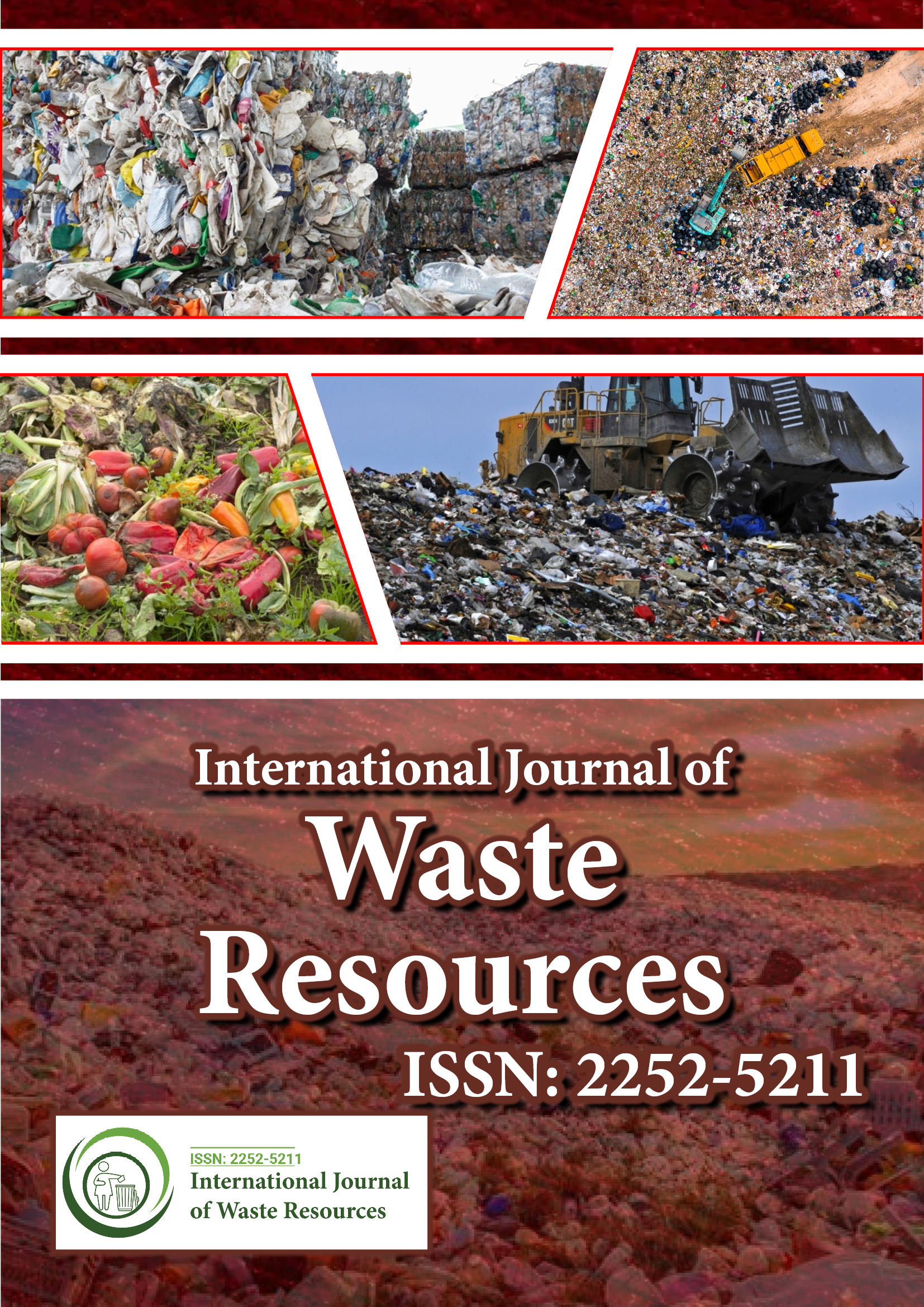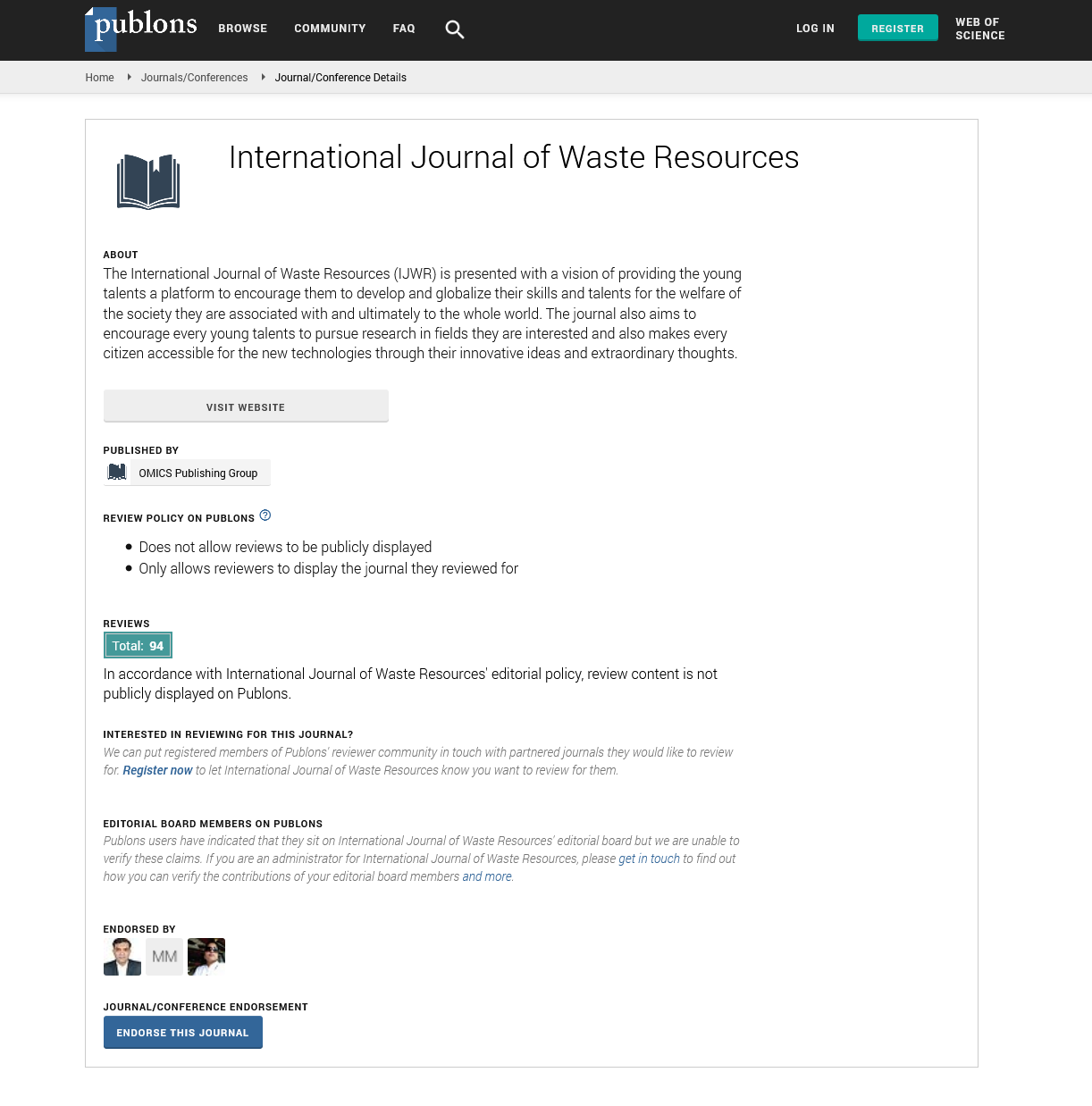Indexed In
- Open J Gate
- The Global Impact Factor (GIF)
- Open Archive Initiative
- VieSearch
- International Society of Universal Research in Sciences
- China National Knowledge Infrastructure (CNKI)
- CiteFactor
- Scimago
- Ulrich's Periodicals Directory
- Electronic Journals Library
- RefSeek
- Directory of Research Journal Indexing (DRJI)
- Hamdard University
- EBSCO A-Z
- Publons
- Google Scholar
Useful Links
Share This Page
Journal Flyer

Open Access Journals
- Agri and Aquaculture
- Biochemistry
- Bioinformatics & Systems Biology
- Business & Management
- Chemistry
- Clinical Sciences
- Engineering
- Food & Nutrition
- General Science
- Genetics & Molecular Biology
- Immunology & Microbiology
- Medical Sciences
- Neuroscience & Psychology
- Nursing & Health Care
- Pharmaceutical Sciences
Commentry - (2025) Volume 15, Issue 2
Waste to Energy: Converting Municipal Solid Waste into Useful Renewable Power
Lingyi Tang*Received: 30-Apr-2025, Manuscript No. IJWR-25-29430; Editor assigned: 02-May-2025, Pre QC No. IJWR-25-29430; Reviewed: 16-May-2025, QC No. IJWR-25-29430; Revised: 23-May-2025, Manuscript No. IJWR-25-29430; Published: 30-May-2025, DOI: 10.35248/2252-5211.25.15.613
Description
Waste to Energy (WTE) is a sustainable process that converts Municipal Solid Waste (MSW) into usable forms of energy, such as electricity, heat, or fuel. As global waste generation continues to increase due to population growth and urbanization, waste to energy offers a dual benefit: reducing the volume of waste that ends up in landfills and producing alternative energy from nonrecyclable materials. This approach not only addresses growing environmental challenges related to waste disposal but also contributes to the diversification of energy sources, making it a critical component of circular economy and renewable energy strategies.
Municipal solid waste typically consists of household garbage, food scraps, plastics, paper, textiles and non-hazardous industrial waste. While recycling and composting help divert a significant portion of this waste, a considerable amount remains nonrecyclable and is often sent to landfills. Landfilling not only consumes valuable land but also generates methane, a potent greenhouse gas. Waste to energy systems offer an alternative by extracting energy from this residual waste, reducing reliance on landfills and fossil fuels.
There are several technologies used in waste to energy systems. The most common method is incineration, where waste is burned at high temperatures in specially designed facilities to produce steam, which drives turbines to generate electricity. Modern incinerators are equipped with advanced air pollution control systems that capture harmful emissions such as dioxins, furans and heavy metals, ensuring compliance with environmental standards. Besides electricity, the heat generated from incineration can be used in district heating systems, making the process more efficient.
Another waste to energy technology is gasification, which involves heating waste in a low-oxygen environment to produce a synthetic gas known as syngas. Syngas is a mixture of carbon monoxide, hydrogen and methane and can be burned to generate electricity or further processed into transportation fuels or chemicals. Compared to incineration, gasification produces fewer emissions and allows for more efficient energy recovery. However, it requires more complex infrastructure and consistent waste composition to operate effectively.
Pyrolysis is a related technology where waste is decomposed at high temperatures in the absence of oxygen. This process yields char, liquid oil and gases, all of which can be utilized as fuels or raw materials for various industrial processes. Pyrolysis is particularly effective for treating plastic waste, rubber and other organic materials, offering a way to convert problematic waste into valuable energy resources.
Anaerobic digestion is a biological method of waste to energy conversion that involves breaking down organic matter such as food waste, agricultural residues and sewage sludge in the absence of oxygen. This process produces biogas, primarily composed of methane and carbon dioxide, which can be used for heating, electricity generation, or even refined into renewable natural gas. The leftover digestate can be used as a soil conditioner or fertilizer, contributing further to sustainability.
The benefits of waste to energy are numerous. Firstly, it significantly reduces the volume of waste requiring final disposal, conserving space in landfills and minimizing environmental contamination. Secondly, it offers a renewable source of energy, especially when derived from biodegradable waste, which is considered carbon-neutral. Thirdly, it helps mitigate climate change by capturing and utilizing methane from organic waste, which would otherwise be released into the atmosphere from landfills. Moreover, waste to energy facilities can be located near urban centers, reducing the need for long-distance waste transport and enhancing local energy security.
Despite its advantages, waste to energy also faces criticism and challenges. One concern is the emission of air pollutants, particularly from incineration processes. Although modern facilities use advanced filtration and monitoring technologies, public perception often remains negative due to historical instances of pollution. Ensuring transparency, regulatory oversight and community engagement is vital to address these concerns. Additionally, some environmental groups argue that waste to energy may discourage recycling and waste reduction efforts by creating demand for waste as fuel. To avoid this, WTE must be integrated into a broader waste hierarchy that prioritizes reduction, reuse and recycling before energy recovery.
Another challenge lies in the economic feasibility of waste to energy projects. High capital costs for facility construction, operation and pollution control can be a barrier, especially in low- and middle-income countries. However, financial viability improves when energy prices are high, waste disposal costs are rising and policies offer support through subsidies, tax incentives, or feed-in tariffs for renewable energy. Public-private partnerships and international funding mechanisms can also help bridge financial gaps and make projects more accessible.
Globally, countries have adopted different approaches to waste to energy. In Europe, nations like Sweden, Denmark and the Netherlands have embraced WTE as part of their integrated waste management systems, with high rates of energy recovery and low reliance on landfills. Japan and South Korea also rely heavily on incineration with energy recovery. In contrast, many developing countries are still exploring WTE potential, facing challenges in waste segregation, technology access and financing. With growing urban populations and limited landfill capacity, these nations are increasingly viewing WTE as a viable solution to urban waste management.
To maximize the benefits of waste to energy, best practices include promoting source separation of waste, integrating WTE with recycling and composting programs, enforcing strict environmental regulations and conducting thorough feasibility studies before project implementation. Public education and stakeholder involvement play a key role in ensuring that communities understand the environmental and health safeguards in place and support the long-term sustainability of WTE projects.
Conclusion
In conclusion, waste to energy is a vital technology that transforms the challenge of waste into an opportunity for clean, renewable power. By reducing landfill use, minimizing greenhouse gas emissions and producing energy from nonrecyclable materials, WTE supports both environmental protection and energy resilience. While it is not a standalone solution, when combined with other waste management and sustainability strategies, waste to energy offers a practical and forward-looking approach to managing the world’s growing waste problem.
Citation: Tang L (2025) Waste to Energy: Converting Municipal Solid Waste into Useful Renewable Power. Int J Waste Resour: 15:613.
Copyright: © 2025 Tang L. This is an open-access article distributed under the terms of the Creative Commons Attribution License, which permits unrestricted use, distribution and reproduction in any medium, provided the original author and source are credited.

